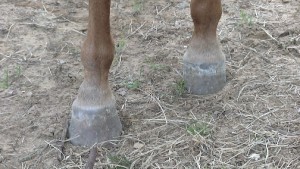 Many people are wondering why some horses grow dense, strong and almost indestructible hooves, while there are some that produce hooves with the consistency of a dead cork. How much do you really know about hoof growth and the factors that affect it? Just like our fingernails, the rate and quality of the hoof’s growth varies. However, unlike with our fingernails, horses depend a lot on their hooves for their survival so having a quality and healthy hoof is an advantage.
Many people are wondering why some horses grow dense, strong and almost indestructible hooves, while there are some that produce hooves with the consistency of a dead cork. How much do you really know about hoof growth and the factors that affect it? Just like our fingernails, the rate and quality of the hoof’s growth varies. However, unlike with our fingernails, horses depend a lot on their hooves for their survival so having a quality and healthy hoof is an advantage.
For a normal adult horse, the hoof wall usually grows at rate of approximately 6 to 10 millimeters per month. At the toe, it takes 9 to 12 months for the hoof horn to grow down from the coronet to the floor surface. Horses with longer feet may take longer time.
The growth rate of hooves in young horses is considerably faster than adult horses. For example, a nursing foal’s foot has a growth rate of about 15 mm per month. As the horse matures, the growth rate of hoofs slows down such as that of a yearling where the hoof’s growth rate is about 12mm per month.
The growth rate of a hoof seems to have a strong direct relationship with the heart rate. The hoof growth rate is faster in young horses as they tend to have a higher heart rate than older horses. Young horses also have faster barefoot growth rate compared to older horses. Horses under 1 year of age grow 2 times faster than those horses that are 12 years of age.
Other than age, hoof growth is influenced by several other factors such as genetics, exercise, external temperature, environment moisture, injury, illness, weight and nutrition.
Genetics – There are breeds that are reputable for the quality and strength of their hoof horn such as Arabians and several pony breeds. Conversely, there are breeds that are known for having poor quality hoofs. Each breed possesses a large deal of variation and often environment plays a large role.
Exercise – When a horse starts its training for athletic activities, it acquires an increase in its metabolic rate which in turn accelerates the growth of the hoof. While highly conditioned horses possess a lower heart rate compared with horses with no activity, their hoof growth is still faster. It seems that the exercise they acquire counteracts the effects of a lower heart rate.
Environmental Moisture – Moisture can influence both the hoof’s growth and strength of its horn. Often, growth rate is increased in wet conditions, as well as due to increased hoof moisture, greater pasture growth and energy intake.
External Temperature – The cold in mid winter tends to reduce rate of hoof growth, while the temperature in spring accelerates it.
Injury – Injuries to the coronary band may also damage hoof wall from that area and may allow the hoof to grow slowly.
Illness and fever – High body temperatures may produce deformity or abnormality on the hoof’s growth. For example, a horse’s hooves may show ‘fever rings’.
Uneven Weight Bearing on Feet – If a horse is suffering from serious lameness in one of its legs and no weight is placed on it then the hoof of the opposite leg that carries all the weight will have a slow growth rate. In addition, this may result to deformation in the hoof capsule.
Nutrition – Nutrition influence includes protein, energy and amino acid intakes as well as metabolism minerals such as calcium and zinc, and vitamins such as vitamin A and biotin. Numerous dietary supplements need to be provided to promote growth of good quality hoof horn. Conversely, if the horse is deprived of these nutrients, the hoof growth rate will be slow and the horn produced will be inadequately strong in supporting the horse’s weight.

